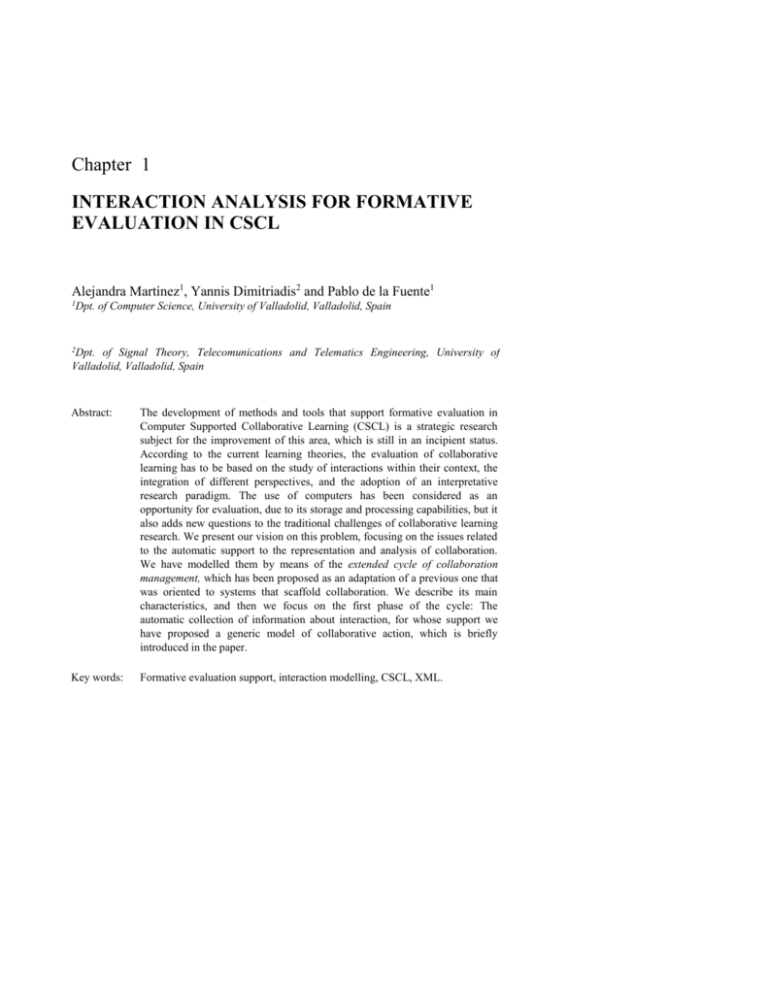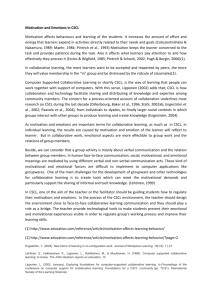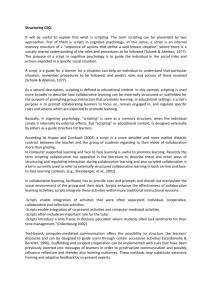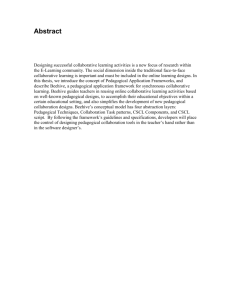2. Formative evaluation in CSCL
advertisement

Chapter 1 INTERACTION ANALYSIS FOR FORMATIVE EVALUATION IN CSCL Alejandra Martínez1, Yannis Dimitriadis2 and Pablo de la Fuente1 1Dpt. of Computer Science, University of Valladolid, Valladolid, Spain 2Dpt. of Signal Theory, Telecomunications and Telematics Engineering, University of Valladolid, Valladolid, Spain Abstract: The development of methods and tools that support formative evaluation in Computer Supported Collaborative Learning (CSCL) is a strategic research subject for the improvement of this area, which is still in an incipient status. According to the current learning theories, the evaluation of collaborative learning has to be based on the study of interactions within their context, the integration of different perspectives, and the adoption of an interpretative research paradigm. The use of computers has been considered as an opportunity for evaluation, due to its storage and processing capabilities, but it also adds new questions to the traditional challenges of collaborative learning research. We present our vision on this problem, focusing on the issues related to the automatic support to the representation and analysis of collaboration. We have modelled them by means of the extended cycle of collaboration management, which has been proposed as an adaptation of a previous one that was oriented to systems that scaffold collaboration. We describe its main characteristics, and then we focus on the first phase of the cycle: The automatic collection of information about interaction, for whose support we have proposed a generic model of collaborative action, which is briefly introduced in the paper. Key words: Formative evaluation support, interaction modelling, CSCL, XML. 2 1. Chapter 1 INTRODUCTION The area of Computer Supported Collaborative Learning (CSCL) is a recent research paradigm in educational software, based on the application of computer networks to collaborative learning processes. From a theoretical perspective, CSCL is based on social theories on learning [1,2] that emphasise the role of social interaction in the construction of knowledge. The development of CSCL systems is very complex, due to its interdisciplinary nature, the diversity of actors implied in the process, and the variety of aspects that must be considered: learning improvement, school organization, software design, distributed systems, human-computer interaction, etc. After the initial years of the paradigm, when the main efforts were oriented towards the design of innovative CSCL systems, it is now necessary to focus on their evaluation, in order to detect appropriate lines of research and development that might contribute to enrich the field. Given the nature of the area, these evaluation processes are complex, and can be oriented to any of the aforementioned issues. During the nineties, the evolution of theories on collaborative learning led the researchers to consider interactions as the main unit of analysis, which thus became the basis for the study of collaboration [3]. More recently, the situated learning approach has highlighted the intrinsic relationship between socio-cultural context, social interaction and human cognition, and proposes the use of an interpretative paradigm for the study of learning process in contrast with the traditional methods [4]. This vision is accepted nowadays by the scientific community, but it poses many challenges, both in the definition of theoretical models able to integrate all the desired analytical perspectives (social, interactive and individual), and in the proposal of methodological tools for the support of an interpretative approach for evaluation [5]. Our interest in these problems is due to our current work in the refinement of the DELFOS framework. DELFOS (“a Description of a teleEducational Layered-Framework Oriented to Learning Situations”) [6] was defined in order to support the design of CSCL applications. We are working in the refinement of the issues related to the formative evaluation of the applications, of the learning processes supported by the tools defined in the framework, and of the framework itself. This has led us to identify the problems that CSCL poses to the support of evaluation, and to propose a generic model of the process of evaluation support, on which we have based the revision of the existing proposals related to this problem in the literature [7]. As a result of this revision, we have proposed a mixed method of evaluation that integrates automatic analysis processes in an overall interpretative evaluation framework. The tools that support these automatic 1. Interaction Analysis for Formative Evaluation in CSCL 3 processes aim at increasing the efficiency of the normally demanding interpretative evaluation procedures, in order to enable the teachers to carry out the formative evaluation processes as part of their normal activity in the classroom. These analysis tools have also to be generic and flexible in order to facilitate their application in different CSCL situations. We have proposed a computational model for the representation of collaborative action that supports the aforementioned requirements of efficiency, generality and flexibility. The mixed method and the model for the representation of action have been thoroughly described respectively in [8] and [9]. In this paper we aim at providing an overview of the problem of the support to formative evaluation in CSCL, pointing out what we think are the main issues that must be taken into account. The paper has the following structure: after this introduction, the section two presents the context and implications of the general problem of evaluation support in CSCL. Then, the section three focuses on the description of the model of the evaluation support process we have proposed: the extended cycle of collaboration management. The section four outlines our proposal of a computational representation of collaborative action based on XML. The paper finishes with the main conclusions drawn from our experience in this area, and the open lines of research. 2. FORMATIVE EVALUATION IN CSCL In this section we will present our vision about evaluation as a formative process based on an interpretative research paradigm that leads to the use of qualitative methods for evaluation, and the problems posed when this vision is applied to the CSCL domain. Evaluation is a very wide term that can pursue different goals and refer to a large number of aspects. In our work we focus on formative evaluation processes, which can be understood as those that help to gain insight into some aspect of reality with the aim of improving it. Evaluation conceived as such is performed continuously along the learning process, which becomes the main objective of evaluation. Formative evaluation can be considered as a form of research that aims at achieving practical goals, and therefore, is influenced by the research paradigm that is adopted. We distinguish between two main research paradigms: the positivist and the interpretative. The former considers knowledge as something objective, which can be “discovered” through studies that seek scientific rigor as the main quality criterion, which results in a decrease in the meaningfulness of the case. The latter considers that knowledge is built in interaction with the environment, and it is based on the study of real experiences in all its complexity, and with 4 Chapter 1 methodologies that place a high value on the participation of the members of the community [10]. As mentioned beforehand, CSCL is based on theories of learning that emphasise its situated nature so that evaluation cannot avoid the social and cultural context on which the learning processes take place [1]. The interpretative approach to evaluation is closer to this perspective than the positivist one, and thus, it is the vision we have adopted in our work. This option yields a number of consequences, namely: the preference for the study of real scenarios (learning taking place in curriculum based experiences) as opposed to experimental situations, the study of the process as a main part of the evaluation, an inductive style for the evaluation designs, and the adoption of ethnographic methods for the collection and analysis of the data. These methods include the observation of the activity throughout a long period of time, interviews to the participants, video and audio recording, etc. [11]. The use of these ethnographic methods in computerbased environments offers new opportunities for research, such as the possibility of setting up new learning situations, and the use of the computer as a new tool for the collection and analysis of data. However, computer support to ethnographic research poses new problems, too. We consider the following ones to be the most important: – Access to the sources of data. The access to the field is a known problem in ethnographic research, and the evaluation designs defined under this perspective consider explicitly how to face them [11]. In the case of studies based on automatically collected data, it will be necessary to solve the technical problems related to data access, such as the need of getting the appropriate rights from the system administrator to access the system logs. The tools will have to include specific functions to collect interactions, which should be independent of the code of the CSCL applications in order to provide modular solutions, and transparent to the users so that they do not interfere in the learning processes. – Management of large quantities of data with low semantic value. The computer provides the possibility of storing all the actions performed by the users with little or no effort. This can lead to a saturation of data with no meaningful value, impossible to process either automatically or manually. Thus, it is necessary to face the problem of the internal representation of the data so that it can support the analysis process. – New types of interaction. The introduction of computer networks promotes new forms of interaction, and with them, new challenges for research in collaborative learning. Crook [12] distinguishes between interactions in front of the computer (small groups that work on the same computer); through the computer (communication or actions performed mediated by the network); and around the computer (interactions that take place at classrooms where work is supported by computers). Table I 1. Interaction Analysis for Formative Evaluation in CSCL 5 presents the relationship among different aspects that must be taken into account in an evaluation process and the possible data sources that can be used in an ethnographic study, showing which of them are the most appropriate data sources for each one of the different aspects. Examining the table, it can be seen that the data collected by the system are the only source appropriate for the study of the interactions that occur through the computer, and thus, they play an important role in the evaluation of CSCL experiences. Additionally, data collected automatically can be used, in a complementary mode with other data sources, for the study of the interactions in front of the computer and the students’ attitudes. The table also shows that the global evaluation process has to consider a number of sources of data and evaluation issues. Therefore, the integration of all these issues should be a main objective in the design of evaluation processes of quality. Table 1-1. Levels of suitability of different sources of data for the study of a number of aspects that can be included in the evaluation of a CSCL environment. Notation: : the method is very appropriate, ~: the method is not totally suited to the aspect; –: the source of data is not suitable for studying the corresponding evaluation aspect. System Audio, Video, Post-hoc Interviews Questionnaires events Observations comments Int. in front of ~ the computer Int. through the ~ computer Int. around the ~ ~ ~ computer Int. outside the classroom Opinions Attitudes ~ ~ ~ – Presentation of results. A known problem in qualitative research is the large volume of data that have to be managed, which, as mentioned above, is usually increased with the use of computers. In order to perform evaluation and make it possible in real situations, it is necessary to reduce this volume and show the results to the evaluator in an intuitive manner. The use of graphical methods of visualisation can help to achieve these objectives, and the computer can be a convenient tool for the production of these graphical representations. – Ethical and privacy issues. As in every research process, the participants of the experience have to be informed of the fact that they are being observed, of what is the scope of these observations and of what are the objectives of the study. They have to be given the possibility of autoexcluding themselves from the evaluation. In order to provide for these issues, the systems that support evaluation should include specific 6 Chapter 1 functions, such as filtering the data of those persons that do not want to be observed or converting the data related to identity in order to increase privacy. – Study of the impact of the introduction of the technological system. Last, but not least important, the introduction of computers for the support of collaborative learning implies the need of studying the impact of these media on the learning processes and on the overall culture of the classroom. Therefore, the adoption of an interpretative paradigm leads to the use of ethnographic methods of research for carrying out the evaluation. We have seen that the computer yields new opportunities to support these methods but it also presents new requirements. In order to give an answer to these challenges, an integrated evaluation system is required, where data coming from the computer can be combined with others taken from traditional ethnographic sources of data. Our group has proposed a mixed evaluation method that faces these requirements [8]. Here, we will focus on the issues related to the automatic support to the analysis of collaboration. We have based the study of this problem on the definition of a generic model of the evaluation support process, which is presented in the next section. 3. THE EXTENDED CYCLE OF COLLABORATION MANAGEMENT In this section, we describe the extended cycle of collaboration management, which we have proposed as a generic model for the systems that perform analysis of interactions in order to support collaboration. This extended cycle has its origin in our effort to adapt the cycle of collaboration management proposed in [13] to the scope of the systems that support evaluation. The original cycle of collaboration management focused on the systems that aim at providing on-line support for the collaborative learning processes. We will refer to them as scaffolding systems, as opposed to the evaluation support systems, that are the ones on which we are focusing in this paper. In spite of the fact that both processes (scaffolding and evaluation) share the need of performing analysis of interactions in order to build a model of the state of collaboration, the differences between their final objectives led us to propose an extension to the original model, in order to focus on the specific issues of evaluation. What are the differences between scaffolding and evaluation? From our point of view, the main ones are the moment on which the intervention takes place, and the need of ideal models of collaboration. Regarding the moment of the intervention, scaffolding has stronger restrictions than evaluation, as it 1. Interaction Analysis for Formative Evaluation in CSCL 7 has to be done in “real time”, during the learning activity, so that the corrections can be applied by the learners in order to improve the learning process. On the other hand, evaluation is usually performed when the activity being evaluated (or a part of it) has finished. Therefore, scaffolding will need to implement some sort of predictive modelling, while this is not the case with evaluation. Regarding the need of an ideal model of interaction, scaffolding, due to its objective of providing advice to the students, needs an ideal model on which to base these instruction decisions. This does not happen in evaluation, a more exploratory process that has as a major objective the understanding of the processes themselves. Figure 1-1. The extended cycle of collaboration management. The upper part shows the functions and tools oriented to support evaluation, while the scaffolding systems are shown in the bottom part, which is adapted from [13]. The figure shows the similarities and differences between the two types of systems, and the types of tools that support both processes according to the level of computational support of the processes. Figure 1 shows the extended cycle of collaboration management, including the different phases that compose the two processes: – Collection of interaction data. It is the first step in both processes, and it is basic for the posterior analysis. The kind of data that is collected, and more specifically, their semantic value, granularity and level of abstraction are fundamental for supporting a good quality analysis. It is necessary to note that, besides the data collected from the computer, both scaffolding and evaluation can be supported by other data collected from the environment. In this phase, the main problems refer to the access to the data and their representation in computational format. – Modelling the interaction state. This phase consists of the steps performed in order to transform the collected raw data into a set of indicators that reflect a model of the interaction. These indicators provide information about the state of the collaboration. The main difference between scaffolding and evaluation at this point is that in the former the 8 Chapter 1 models are built while the collaboration is taking place, and therefore they can need to predict a number of aspects about the collaborative processes, which is not the case in evaluation. – Analysis: Diagnosis vs. understanding. In this third phase, the model of interaction is analysed with different purposes that depend on the particular cycle being considered. In scaffolding, the model is compared with an ideal model of interaction (implicit or explicit) in order to detect possible mismatches that will lead to some kind of advice to the learners. In evaluation, the main objective is to show the results of the analysis to allow the evaluator to understand the process in an efficient manner. – Feedback: Corrections vs. refinement. In scaffolding, the result of the process takes the form of a set of advises or correcting actions which, according to the analysis, could bring the state of collaboration closer to the desired state. Evaluation has a wider scope, and can be oriented to suggest changes on many different issues such as the setting up of the situation, the scheduling of the activities, the attitudes of the participants, etc. Besides the description of the phases, the cycle of collaboration management allows to classify the collaboration analysis tools, according to the level to which they provide automatic support. In the case of scaffolding, it is possible to distinguish between mirroring, metacognitive and advising tools [13]. Regarding the systems oriented to evaluation, we distinguish between reproduction tools and evaluation support tools. The former take the data collected from the computer and show them with no intermediate processing, as if it had been video-recorded. On the contrary, the evaluation support tools are able to extract indexes that can be shown to the evaluator, who will combine them with other sources of data and methods of analysis, in order to extract the formative corrections that will feed again the collaborative learning process. Finally, as it can be observed in the figure, there is a question mark at the last phase of the evaluation support cycle. This place would correspond to systems that were able to provide the teacher or the student with formative corrections about the studied processes. Therefore, this would be a sort of expert system oriented to evaluation, that given a set of inputs (not all of them necessarily provided by the computer), proposes a series of changes to the environment, based on some kind of knowledge about CSCL systems. We do not think that such a kind of system is possible, especially if we recall the issues that arise from the adoption of an interpretative paradigm, although it can be considered as an open line of research, which we have denoted by a question mark (?). Based on the discussion presented in this section, it can be concluded that the systems that support evaluation present features that distinguish them from the systems that scaffold collaboration, and therefore it makes sense to 1. Interaction Analysis for Formative Evaluation in CSCL 9 consider them separately. However, in practice, this distinction is not so clear, and many aspects of the tools oriented to scaffolding will apply to evaluation support ones and vice versa. For example, the metacognitive tools and the evaluation support tools perform the same kind of activities. We refer to the two types of tools as interaction analysis support tools. As it has been discussed, the definition of an appropriate model for the representation of the data they collect about collaboration is basic for the support of all the phases that theses systems perform. The next section will briefly discuss our proposals related to this aspect. 4. AUTOMATIC DATA COLLECTION AND MODELING The first phase of the process of collaboration management relies on an appropriate data representation, able to support the rest of the phases that take place in the extended cycle. To achieve this objective, the representation of the actions performed by the participants has to meet the following criteria: it has to be generic to be able to integrate the different sources, flexible so that it can be adapted to different analytical perspectives, and represented at an appropriate level of abstraction, so that it can be processed either manually or computationally. Finally, it has to be expressed explicitly in a standard language in order to promote interoperability. Existing proposals for interaction modelling do not meet all these requirements. Either they are constrained to a single source of data, or they do not make explicit the representation format they use. Some systems rely on dialog analysis, usually based on some form of pre-codification performed by the participants, like EPSILON [14]. Others base the analysis on actions performed on structured shared workspaces, like the system proposed in [15], which presents interesting opportunities for research, but is restricted to these structured interfaces. Moreover, none of these proposals offers an interoperable solution based on an explicit and standard representation of the interactions. As an answer to the absence of a model for the representation of collaborative action that met the desired requirements, we have proposed an XML-based representation of collaboration action. We have chosen XML [16] as it is a widely accepted standard that provides a common and understandable representation of the vocabulary, and can help to improve reusability, modularity and interoperability of the applications. The two main problems we have faced at defining the model are the need of modelling the context of the collaborative situations, and the need to provide a generic 10 Chapter 1 model able to represent the different types of interactions that take place in different collaborative situations. Regarding context, although research in CSCL currently agrees on the need of considering context when interpreting human action, it is an open issue how this is to be done, and what elements should be considered when modelling it, especially from a computational perspective. Apart from very few exceptions, the model of context is usually performed ad-hoc, according to the particular needs of the situation being evaluated. As an alternative, we have proposed the use of the concepts of the DELFOS framework for the description of context in the model of collaborative learning. The second aspect we have faced in our proposal is to provide a generic and operational taxonomy for the representation of collaborative action. As mentioned beforehand, existing approaches focus on the representation of a single feature of the interaction, which hinders the desired integration of different sources of data that are diverse in origin and in nature. We aim at integrating dialog and action, as well as automatic and manually collected data in a common structure, by means of a new classification that focuses on the agents that take part in interactions. This way, the proposal distinguishes between direct, indirect and participation-oriented interactions. They are further defined in their elements. The main advantage of this approach is that it easily accommodates to the data collected in each system for each type of interaction. The validation of the model has been performed by its application to three different case studies [7]. These cases have shown that the model is valid for the representation of interactions coming from distinct data sources, like face-to-face interactions; answers to sociometric questionnaires; indirect actions performed through a document sharing workspace, as well as through a structured interface workspace consisting on a puzzle game for kindergarten children. Our experience in the use of the model shows that it has been expressive enough for situations of distinct characteristics, and that it is a powerful tool for supporting our mixed approach to evaluation, providing an important increase of efficiency in its procedures [8]. 5. CONCLUSIONS AND FURTHER WORK In order to contribute to the problem of evaluation support in CSCL, our group has proposed a mixed evaluation method and a model for the representation of action in CSCL. In this paper we have introduced some of the issues that have been considered in order to define these two proposals. The adoption of a situated learning perspective for the study of CSCL leads to the need of assuming an interpretative paradigm for evaluation. This leads 1. Interaction Analysis for Formative Evaluation in CSCL 11 to a number of challenges, which have been identified and discussed in this paper. Focusing on the automatic support to evaluation, we have defined the extended cycle of collaboration support, that models all the systems that perform analysis of interactions in order to support collaboration, either in order to intervene in the processes (scaffolding) or in order to understand the processes in depth (evaluation). By defining the extended cycle, we provide conceptual framework that points out the specific issues related to evaluation as opposed to scaffolding, while we also highlight the similarities between the two processes. We have proposed an XML-based representation of collaborative action, independent of the analytical approach, adaptable to different scenarios, and suitable for the representation of data coming from different sources, including field work as well as automatically collected data. One long-term objective of our group is to provide a component-based architecture where different modules can be plugged-in in order to fulfil the functions needed in CSCL situations, yielding the desired benefits of reusability. The model of collaborative action we have proposed and introduced in this paper can be used in order to design a set of generic, flexible and interoperable storing components. These components could provide interaction data suitable to be processed by different analysis components. We are currently working towards the integration of the model in a component-based system for CSCL [17], which will eventually lead to this modular and reusable solution. We encourage other members of the scientific community to use the model we propose in order to refine it and increase its generality. ACKNOWLEDGEMENTS The authors want to thank to all the members and collaborators of the Transdisciplinary group EMIC of the University of Valladolid for their contributions. The work presented in this chapter has been partially supported by the Spanish Ministry of Science and Technology (projects TIC2000-1054 and TIC-2002-04258-C03-02), the autonomous government of Castilla y León (project VA 117/01) and by Ediciones Don Bosco (Edebé). REFERENCES 1. T. Koschmann, “Paradigms shift and instructional technology”, in CSCL: Theory and Practice of an Emerging Paradigm, T. Koschmann, Ed., pp. 1-23. Lawrence Erlbaum Associates, N.J, 1996. 12 Chapter 1 2. 3. 4. 5. 6. 7. 8. 9. 10. 11. 12. 13. 14. 15. 16. 17. P. Dillenbourg, “Introduction; What do you mean by “Collaborative Learning”?”, en Collaborative Learning. Cognitive and Computational Approaches, Pierre Dillenbourg, Ed., pp. 1-19. Elsevier Science Ltd., Oxford, 1999. P. Dillenbourg, M. Baker, A. Blaye, y C. O'Malley, “The evolution of research on collaborative learning”, in Learning in Humans and Machines. Towards an Interdisciplinary Learning Science, H. Spada y P. Reinmann, Eds. Elsevier Science, Oxford, first edition, 1995. J.G. Greeno, “The situativity of knowing, learning and research”, American Psychologist, vol. 53, pp. 5-17, 1998. B.G. Wilson y K.M. Myers, Theoretical Foundations of Learning Environments, chapter, Situated cognition in Theoretical and Practical Context, pp. 57-88, Lawrence Erlbaum Associates, N.J., 2000. C.A. Osuna y Y.A. Dimitriadis, “A framework for the development of educational collaborative applications based on social constructivism”, in Proceedings of CYTED RITOS International Workshop on Groupware, CRIWG '99, Cancún, Quintana Roo, pp. 71-80, IEEE Computer Society Press, 1999. A. Martínez. “A model and a method for the computational support of evaluation in CSCL” (in Spanish), unpublished PhD Dissertation, University of Valladolid, Valladolid, 2003. A. Martínez, Y. Dimitriadis, B. Rubia, E. Gómez, P. de la Fuente, “Combining qualitative and social network analysis for the study of social aspects of collaborative learning”, accepted in Computers and Education, special issue on Documenting Collaborative Interactions, 2003. A. Martínez, Y. Dimitriadis and P. de la Fuente, “Towards a standard XMLrepresentation of collaborative action”, in Proceedings of CSCL 2003, Bergen, 2003 (to appear). G. Rodríguez Gómez, J. Gil Flores, y E. García Jiménez, Qualitative research methodology, (in Spanish), Ediciones Aljibe, Málaga, 1999. J.P. Goetz y M.D. LeCompte, Ethnography and qualitative design in educational research, Academic Press, Orlando, FL, 1984. C. Crook, Computers and the collaborative experience of learning, Routeledge, London, 1994. P. Jermann, A. Soller, y M. Muehlenbrock, “From mirroring to guiding: a review of the state of the art technology or supporting collaborative learning,” in Proceedings of EuroCSCL 2001., pp. 324-331, Maastricht MacLuhan Institute, Maastricht, 2001 A. Soller. “Modelling the process of collaborative learning”, in Proceedings of the International Workshop on New Technologies in Collaborative Learning, AwajiYumebutai, 2001. M. Mühlenbrock, Action-Based Collaboration Analysis for Group Learning, IOS Press, Amsterdam, 2001. Extensible Markup Language (XML), 2000, http://www.w3. org/XML/. Y. Dimitriadis, J.A. Asensio, J. Toquero, L. Estébanez, T.A. Martínez and A. Martínez, “Towards a software component based system for the domain of Computer Supported Collaborative Learning (CSCL)” (in Spanish), in Proceedings of Symposium on Informatics and Telecommunications, SIT 2002, Sevilla, 2002.








